
Design Essentials for the Motion Media Artist – who is this book for?
This book was written for people I meet at trade shows and seminars who say “I’ve learned the software but my designs still look terrible. What am I doing wrong?”
This book is also for you if you’re a student or are new to motion graphic design. While teaching design students I found it frustrating recommending ten books to each student to cover the basic design principles for the foundation year of their degree course in Graphic Design. The university library never had enough books. The students couldn’t afford to buy the books they needed. Ironically, they only really needed one chapter from each to provide what they needed to get started. If only all that information could be provided in one book!
What will it teach me?
The book is designed as a one-stop, getting-started guide for anyone new to motion graphic design who wants to get the basic principles under their belt so they can get started quickly, making better design decisions as they work through the chapters.
After reading this book you’ll feel comfortable with the basic concepts and principles of design, animation and editing. There’s a chapter on drawing that teaches you the importance of “learning to see” through fun drawing exercises. Among other things, you’ll learn how to choose color combinations that work and how to create convincing and compelling movement in your animations. It will also help you choose fonts that work and improve composition with balance and elegance.
Inspiration
At the end of each chapter, a well-respected creative professional will talk about how their work incorporates some of the principles taught in the book. This helps you see the importance of these principles and to understand how they eventually become second nature to artists and designers.
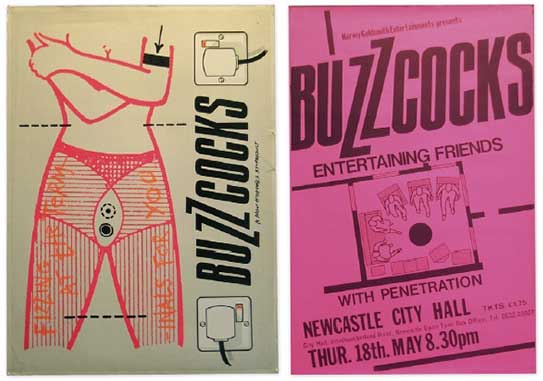
Record Sleeve designs for Buzzcocks by Malcolm Garret
Learn from some of the top people in their respective industries. The book includes “Inspiration” sections written by graphic designer and creative director Malcolm Garrett and musician Joan Armatrading amongst others. The Foreword to the book is written by commercial director and photographer, Rob Chiu (AKA The Ronin).

Where will it take me?
“Design Essentials” confidently points you in the right direction on the road to becoming a better designer and animator. The book presents the principles of design in an engaging and inspiring way. Each principle is explained in plain English with illustration, and photography where necessary. As well as mastering the fundamental concepts and principles of motion graphic design, with my creative approach to teaching, you’ll learn how to manipulate and bend the rules to create something unique that will also achieve your communication goals.
Once you’ve finished reading this book you should have the confidence to implement what you’ve learned to your motion graphics projects. There’s also an extensive Recommended Reading List on this website that will help you decide where to go next so you can increase your knowledge of these basic principles even further. There’s also a page featuring links to all the external resources mentioned within the pages of my book.
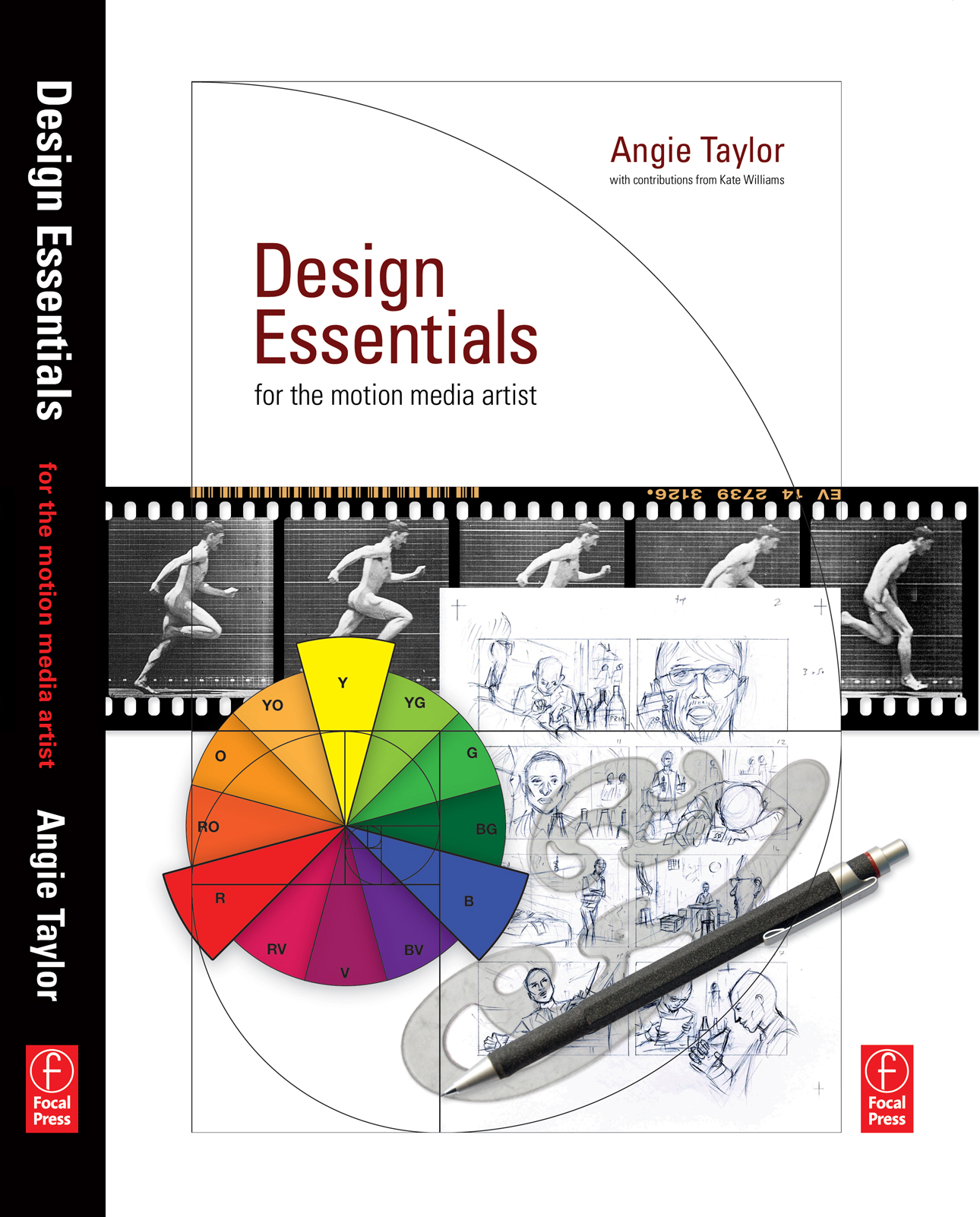
Design Essentials Resources provides chapter links for Angie Taylor’s book, Design Essentials for the Motion Media Artist. There are several references made to influential work from other designers, file downloads and websites of interest in the chapters of my book. Here is a list of them broken down, chapter-by-chapter;
Design Essentials – 01 Drawing Chapter
Here’s a summary of links quoted in the Drawing Chapter;
I usually use a propeller pencil for sketching when I’m on the move (sometimes known as a propelling pencil or a mechanical pencil). Rotring makes a great range of propeller pencils including their Tikky range.
I use a variety of pens but for disposable fiber-tips or roller-balls visit www.pilotpen.com.
Obviously you can’t easily erase pen marks in the same way that you can with pencil marks. A solution to this is to use correction fluid (or liquid paper) such as Tip-ex to cover over any errors. Once the correction fluid has dried, you can then draw on the surface www.liquidpaper.com.
Brushes are described by shapes and sizes. The shapes include round, flat, fan, and angled. Sizes range from negative values denoted by 4/0 (can also be written as 0000), to positive values indicated by single numbers such as 4. Here are the most common sizes; 4/0, 3/0, 2/0, 0, 1, 2, 4, 6, 8, 10, 11, 12, 14, 16, 18, 20, 22, 24You can refer to this web page for some free brush measurement charts www.dickblick.com/info/brushmeasurement.
Graphic tabelts provide you with much more freedom and versatility than a mouse. You might even find a new style that you wouldn’t achieve from traditional drawing. If you want to find out about Wacom tablets you can visit their website at www.wacom.com.
There are some great tutorials about the Vanishing Point tool and other Photoshop features to help you draw more successfully on Deke McClelland’s fantastically informative, yet compellingly entertaining website at www.deke.com. I’d recommend signing up to Deke.com for fabulous freebies, podcasts and tutorials.
Design Essentials – 02 Planning Chapter
The Alister Buss example seen here was inspired by the famous Saul Bass title sequences for “Anatomy of a Murder” www.saul-bass.com
The Roarke Pearce example seen here was inspired by Anni Albers; www.albersfoundation.org.
There are a few software applications that are good for brainstorming like the fantastic Omni Group applications (http://www.omnigroup.com/) or my personal favorite, Zengobi’s Curio http://www.zengobi.com/products/curio/
I have provided you with an A4 storyboard template to download from here. Just click on the link on the following page. This will enable you to download an Adobe PDF file that can be re-sized to your chosen dimensions without losing resolution. Print out a copy so that you can develop your own storyboard for your project.
In this movie I shamelessly used lot’s of influences from the 1960’s. Pop Art – opening title sequence – a series of documentaries about design and music from the swinging 1960s.
Design Essentials – 04 Animation Chapter
Here is a link to the example of a Bouncing Ball animation from the Animation page of the website.
The opening titles for Barbarella (by Arcady and Maurice Binder) feature text animation that dances weightlessly around Barbarella in her space ship. You can see this online at the wonderful “The Art of The Title Sequence” website.
One of the most inspiring projects I worked on was Aphex Twin’s infamous “Rubber Johnny” video. I worked alongside director, Chris Cunningham for a year on that project (it was a six-minute music video!). I learned a lot by watching Chris at work.
Another music video artist whose work is worth watching is Michelle Gondry who also has a knack for matching music to imaginative and innovative visuals.
An example of an animated sequence created by rotoscoping (drawing on top of footage or photographs).
In this chapter you can see drawings of a dog’s walk cycle. Here are two examples of the final animation, one where the drawing and animation was done with Corel Painter. Here’s the second animation where the character was redrawn in Adobe Illustrator and then and animated in Adobe After Effects.
A fairly common job that you may be asked to do as a motion graphic designer is to create moving footage by animating around a still image. Panning and Zooming is easily controlled in the Layer panel in Adobe After Effects, here is an Example of panning and zooming around a street map of Edinburgh.
One of the characters I designed for Children’s BBC series “See You, See Me – The Inventors”. John Logie Baird, the Scottish inventor of the television. This was drawn in liiustrator with each body part on a separate layer, ready to be animated in Adobe After Effects.
Design Essentials ResourcesA good practice exercise is to use an application like Adobe After Effects to animate some ordinary text. If you can use animation to convincingly bring life to an inanimate object then you know you’re doing a good job. In this example I’ve taken the word “Accelerate” and animated it as if it is a car being driven off the screen.
Design Essentials – 07 Editing Chapter
The opening title sequence for Midnight Cowboy is a great example of an establishing shot, both character and location are established during the opening title sequence. You can find out more about this title sequence in the Communication chapter.
A little forward planning goes a long way in video and film production and can save oodles of time and money further down the road. You can find out more about how to do this in the Technical chapter. Here’s a Chip Chart to download and print out to help you set up your cameras correctly before shooting footage.
Design Essentials – 08 Communication Chapter
The opening title sequence for Midnight Cowboy is also referred to in the Communication chapter.
Bob Kurtz’s wonderful sequence for the Pink Panther 2 Film is another good example where the opening titles are used to establish the main characters as well as the rough plot.
You can see “Anémic Cinéma” by Marcel Duchamp and Man Ray, as well as many other avante-garde films at a fantastic website named UBUWEB.
Save time by creating a single presentation template that you can use for all clients and pitches. Keep your presentation simple and concise. There’s more information about presentations in the Communication chapter and I’ve included a Design Essentials Presentation Template for you to get started with.
Lady Sovereign’s music video for her track, Hoodie (directed by Family) sees a gang of rough-looking kids, dressed in hoodies, chasing a woman through a shopping precinct. The audience (and the woman) assumes that the gang is planning to mug the woman but at the end of the video it turns out that they are chasing her in an effort to return her bag, which she dropped while shopping. The video is intended to turn stereotypes on their heads and makes the woman look foolish for thinking the worst of the young people.
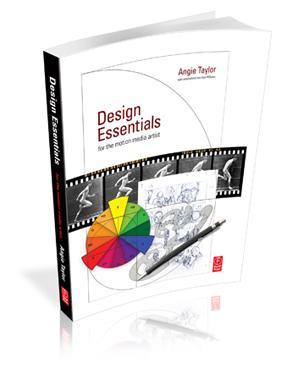
Digital Arts has featured – 12 Rules of Animation – an excerpt from my “Design Essentials for the Motion Media Artist” as their feature article this month. The article is now FREELY AVAILABLE on the Digital Arts website.
Animation as we know it has been around since Horner invented the zoetrope in 1834. Since then animators have developed rules of animation that help us to draw viewers into the world we have created. From Disney classics to the latest stereoscopic 3D productions, we’ve plundered them all to find the 12 key techniques you need to master to be a top-flight animator.
Some of these rules are based on real-life physics, and others on observations and reactions. They provide a set of invaluable ‘tricks’ for animators that have been proven to work in almost every situation.
In the article I delve into the world of animation to pick out the 12 rules of animation that every animator and motion graphics artist must know. Drawn from the forms 150 year history, you’ll learn a wealth of dos and don’ts that will help you produce more engaging projects, whether you’re working in 2D, 3D, graphics, stop-motion or a mixture of them all.
You can pick up both printed copies and digital downloads from the Digital Arts website where you can also find some of my tutorials, tips and tricks.
I’ll also be talking about some of these golden rules of animation in my “Dynamic Text Animation for Motion Graphicswith After Effects” presentation at the Production Fiesta in London on May 6th.
In this session, I will share an in-depth look at the options for working with text in Adobe After Effects. I’ll show examples of successful motion graphic designs and will discuss the components of design that make them work. In this session you’ll earn about the rules of typography and how to apply the rules of typography to your designs to make them easier to read and more dynamic. I’ll also take an in-depth look at the typographic controls available in After Effects and will also show you how you can use hand-drawn text to bring a unique aspect to your designs.
I’ll also be presenting four other sessions at this event which you can find out about here. If you want to register for a full day of valuable creative sessions by me and all the other speakers you can do so here on the Eventbrite page. I hope to see some of you there, please make sure to say hello if you can make it along.


I found this to be a really great book and is suitable for anyone who works or has an interest in motion graphics or animation. It would help someone who is studying at college, but is also very useful for those that have been in the industry a long time. I fall into the later category and was formally trained at art school in the early 80’s but I found it very useful to revisit many of the fundamental ideas that I was taught in those days which give me a solid grounding. It also gave me many new ideas and covered areas that did not exist or were in their infancy when I was a student.
I really liked the sections on colour, typography and especially the section on composition which everyone in the industry should be familiar with but clearly are not. I’m sure this would fill in the gaps for people such as avid editors who have a purely technical background and would also inspire those who are creative technophobes to get stuck in with the computer packages today which frighten many with their complexity.
I have shown the book to my manager at Sky and he will be buying some copies for the post production dept to read. He was was also very impressed.
5.0 out of 5 stars on Amazon
Paul Mark Provencher “ppro” reviewed Design Essentials for the Motion Media Artist: A Practical Guide to Principles & Techniques,

Comprehensive, Wise, Pivotal…
I live in the corporate world of information technology. For the most part, this existence for me is based in an engineering mindset – plan, design, build, test, deliver.
In my IT world, artists are thought to be undisciplined in these areas. Angie Taylor’s book makes it clear that successful artists clearly execute in much the same way as the best scientists. While they bring a creative streak that may not appear…Read More
I live in the corporate world of information technology. For the most part, this existence for me is based in an engineering mindset – plan, design, build, test, deliver.
In my IT world, artists are thought to be undisciplined in these areas. Angie Taylor’s book makes it clear that successful artists clearly execute in much the same way as the best scientists. While they bring a creative streak that may not appear in engineering and science, they owe their success in business to their ability to plan, execute and deliver a satisfactory product on time, on budget.
The author takes the reader through a series of concepts, starting with sketching. At first I didn’t understand what this had to do with Motion Media. But it very quickly became obvious why this was important. The book gives a great primer and cites numerous references (including current online resources) that may be used to dig in deeper.
From there the book explores a number of concepts familiar to practicing artists – composition, story-boards, software packages (again with numerous references to some terrific resources), and all while developing the concepts in a way that follows the workflow of projects.
I am reading this book (and several others) to gain a better command of the concepts I hope to apply to the use of my HD-movie capability of my DSLR. I believe that making movies, even if they end up being glorified home movies of my family, will benefit from a basic understanding of what goes into good motion media.
This book has something to offer beginners like me as well as practicing professionals who need to update their understanding of motion media. I will probably read this book twice – the illustrations are wonderful, and perfectly on point, the explanations are very understandable, even for someone with little experience in this field (though I have been a photographer for a long time).
The many resources cited as places to dig deeper are all quality products and have clearly been vetted thoroughly by the author.
This is a solid book with much to offer. If you’re just getting into motion media like me, or perhaps you’d like to step into the latest tools and concepts, don’t hesitate to buy and read this book.
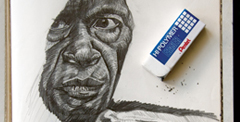
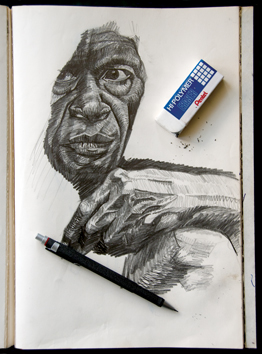
Drawing from Sketchbook © Angie Taylor 1999
It’s a hot debate, as a designer, is it important to have drawing skills? I mean, you don’t need to draw anymore really? Surely computers can do it all for you now, download a few images, treat them with filters, composite them together in Adobe Photoshop – Bob’s yer uncle (as we say in the UK!)
But drawing is not only a process used to create finished aesthetic imagery to include in a finished design, it’s much more than that. It’s a learning process that is an important stage in the development of a confident visual language. When you draw something you learn to see with a different, more focused awareness. You start to question why things appear in a certain way, as a result you can understand how things are constructed, how light interacts with surfaces and how colors affect each other. Things that may not occur to you by just simply looking at an object. you need to truly understand these things to make your drawings work. Even if you don’t like your finished drawings, that really doesn’t matter, it’s the process of losing yourself in the craft of drawing that matters.
And it’s never too late to learn, in the Drawing chapter of my book, Design Essentials for the Motion Media Artist I talk about my mother who didn’t start drawing till she was in her 70’s. It has made a huge difference to her life and now she can draw and paint like she would never have thought. You can check out excerpts from this chapter using Amazon’s “Search Inside” feature now. The chapter also contains some of the exercises that helped me learn to draw during my time at Art College. There’s also a resources section on this website that contains some tips, tricks and links to useful tutorials, websites and a complete reading list.
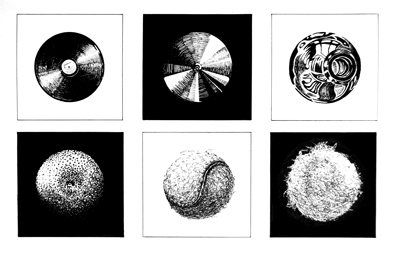
Drawing Exercise from Design Essentials book - draw 6 circular objects with the same drawing implement achieving different textures for each
Writing this book inspired me to include more about drawing in my software tutorial too. I recently recorded a new video training workshop for video2brain on Animation Character Design in Adobe Illustrator which will be available soon. In this tutorial I showed that you don’t need to limit yourself to using traditional drawing materials. In one of the tutorials I show how to create body shapes from primitive shapes and then use Illustrators fabulous drawing tools to sculpt these into more organic shapes, it’s an addictive and very creative process.
So, I hope that you’ll give drawing a chance, pick up whichever implement inspires you to make marks and get sketching! don’t worry about the outcome, just enjoy the process!
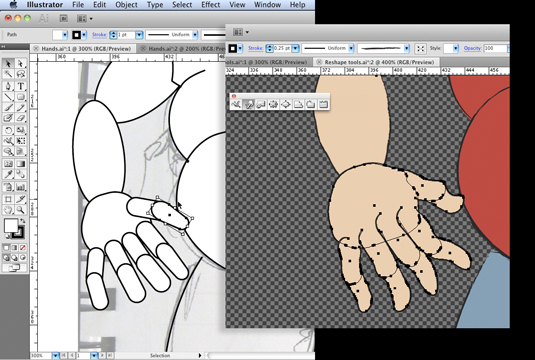
Using primitive shapes in Adobe Illustrator to create complex body shapes © Angie Taylor 2010
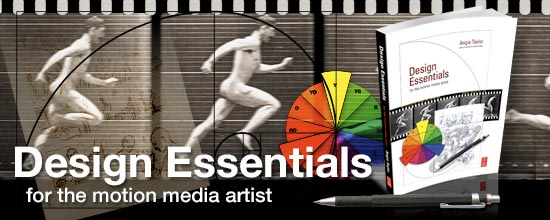
 Did you know tat you can read the first chapter of my “Design Essentials for the Motion Media Artist” free on Amazon Kindle?
Did you know tat you can read the first chapter of my “Design Essentials for the Motion Media Artist” free on Amazon Kindle?














